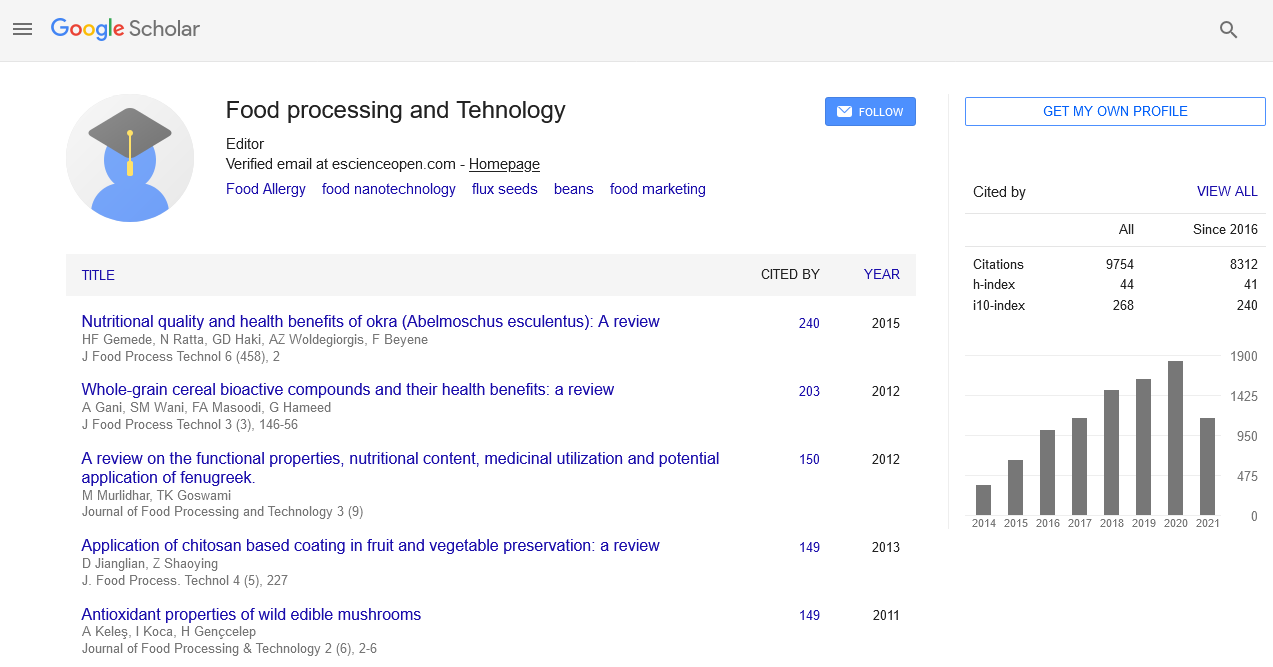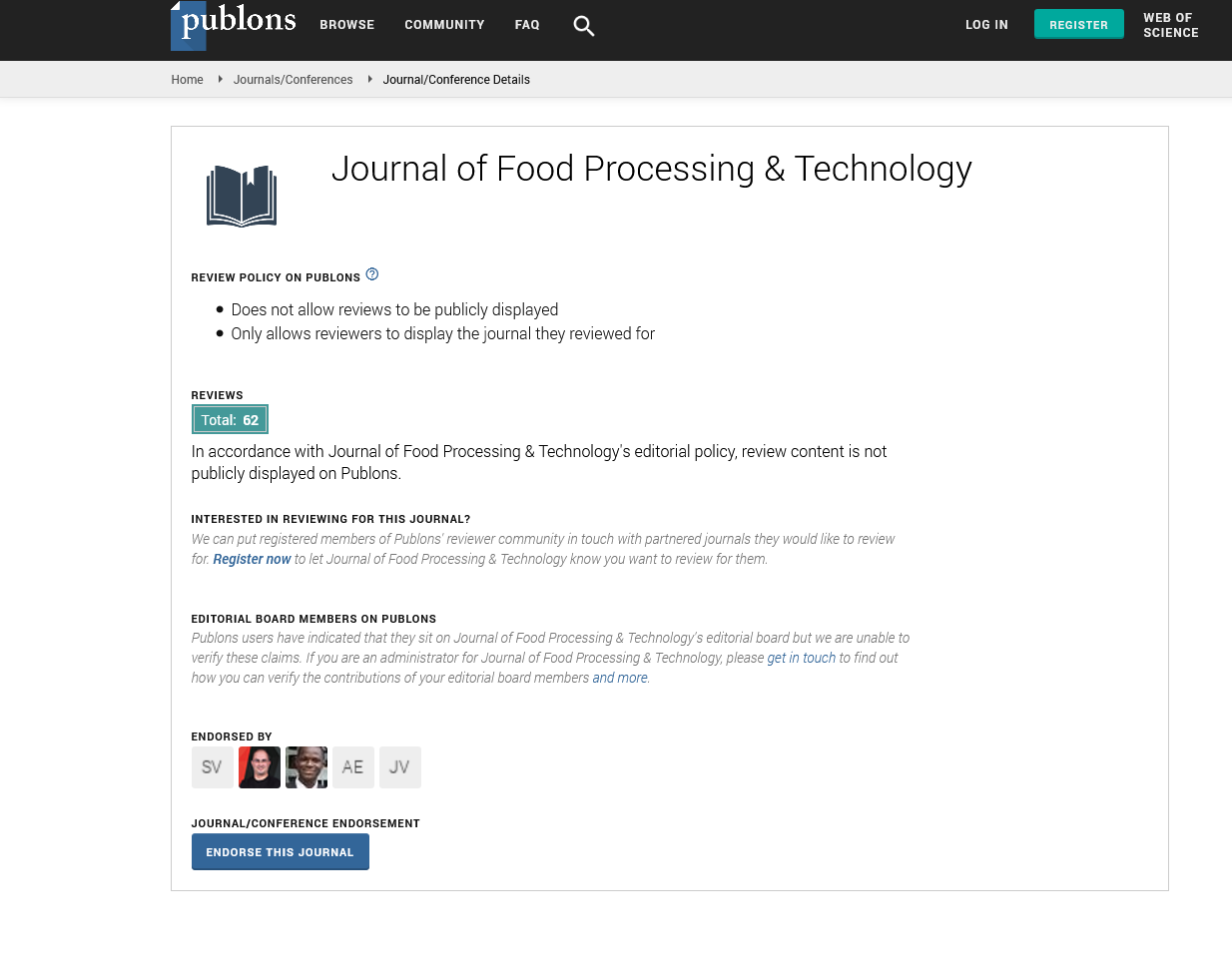Indexed In
- Genamics JournalSeek
- Academic Keys
- JournalTOCs
- China National Knowledge Infrastructure (CNKI)
- Access to Global Online Research in Agriculture (AGORA)
- Centre for Agriculture and Biosciences International (CABI)
- RefSeek
- Directory of Research Journal Indexing (DRJI)
- Hamdard University
- EBSCO A-Z
- OCLC- WorldCat
- Scholarsteer
- SWB online catalog
- Publons
- Euro Pub
- Google Scholar
Useful Links
Share This Page
Journal Flyer
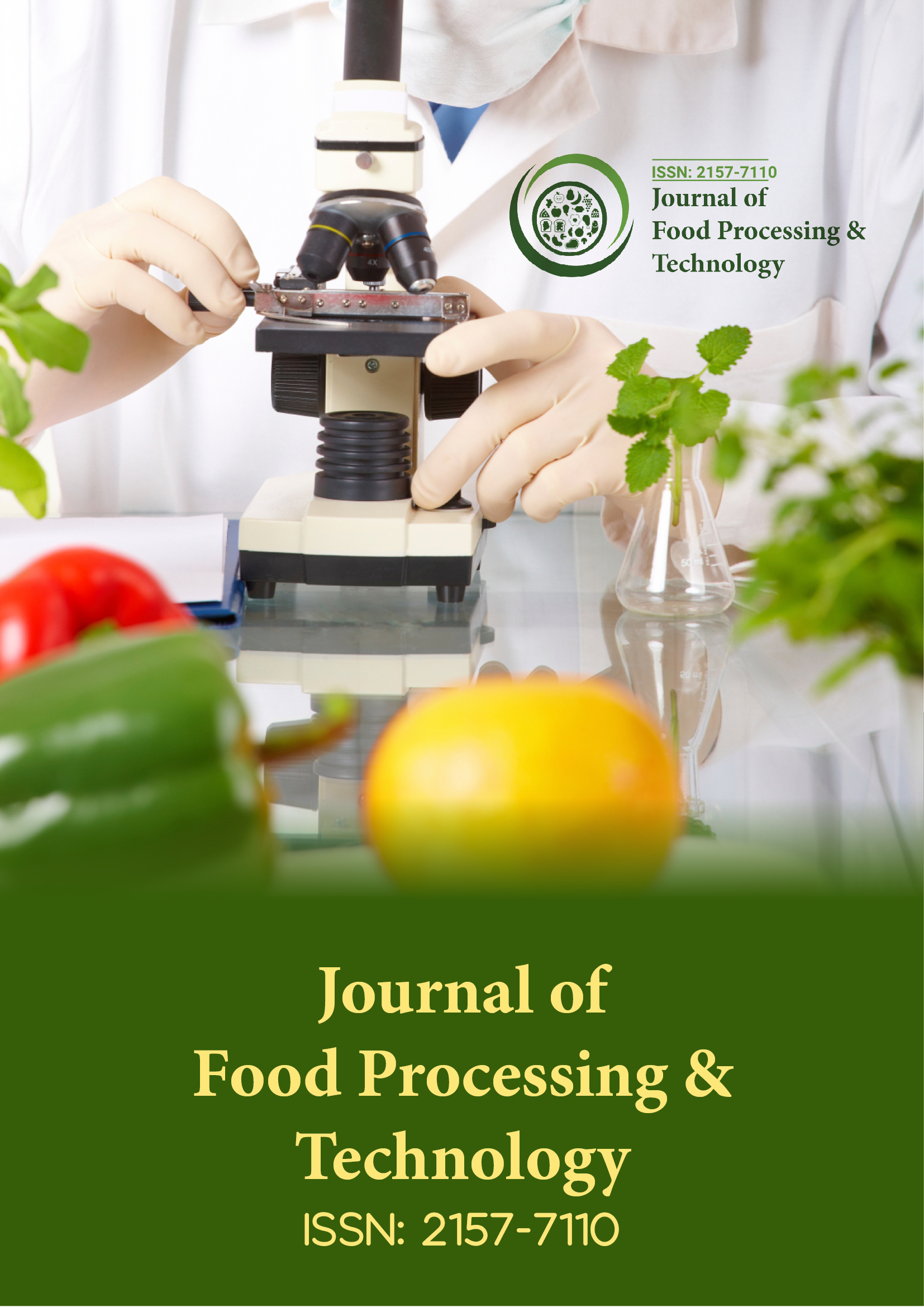
Open Access Journals
- Agri and Aquaculture
- Biochemistry
- Bioinformatics & Systems Biology
- Business & Management
- Chemistry
- Clinical Sciences
- Engineering
- Food & Nutrition
- General Science
- Genetics & Molecular Biology
- Immunology & Microbiology
- Medical Sciences
- Neuroscience & Psychology
- Nursing & Health Care
- Pharmaceutical Sciences
Research - (2019) Volume 10, Issue 7
Influence of Essential Oils and Frozen Storage on Quality Parameters of Catfish (Clarias gariepinus) Burgers and Fingers
Mohamed S Saleem1, Shaban A El-Sherif2*, Ashraf M Sharaf1 and Kamel S Abo-Zeid22Fish Processing Technology Laboratory, National Institute of Oceanography and Fisheries, Cairo, Egypt
Received: 26-Mar-2019 Published: 09-May-2019
Abstract
To increase the utilization of catfish (Clarias gariepinus) obtained from Wadi El Rayan Lake, Fayoum Governorate, Egypt that not preferred by consumers on their fresh status, ready to eat fish burgers and fingers were prepared with using essential oils (EOs); (0.5%) thyme (Thymus vulgaris) and rosemary (Rosmarinus officinalis) individually as antioxidant and antimicrobial agents and enhancement the sensory quality attributes of raw catfish burgers and fingers products. Catfish burgers and fingers treated with tested essential oils and untreated (control sample) were packed in polyethylene bags and stored as raw products in a deep freezer at -18°C for three months. The analysis of physicochemical properties; pH, total volatile basic nitrogen (TVB-N), trimethylamine nitrogen (TMA-N) and Thiobarbituric Acid (TBA) value and Microbiological aspects; Total Bacterial Count (TBC) and yeast and mould (YM) counts were carried out on treated and untreated raw fish products at zero time and periodically every 15 days during storage period. The obtained results showed that all investigated analysis parameters; pH, TVB-N, TMA-N, TBA value, TBC and YM counts were gradually increased during storage period in all raw catfish burgers and fingers products by different ratios depending on the kind of tested essential oil, the increases of these parameters were significantly higher (p<0.05) in the control sample than samples treatment with EOs. The investigated essential oils caused a significant (p<0.05) improve the quality of fish products through retarded the spoilage and enhancement the physicochemical, microbiological and sensory quality attributes for raw fish burgers and fingers during frozen storage, as compared to the control sample. In conclusion, the addition of essential oils showed a positive effect on the product quality and shelf-life as antioxidant and antimicrobial; so, catfish products are of high quality and high acceptance even after the storage period is over.
Keywords
Ready to eat catfish products; Quality parameters; Thyme; Rosemary EOs; Frozen storage
Introduction
Fish and fishery products contain high-quality protein and other necessary nutrients; they are low in saturated fatty acids and contain a high content of unsaturated fatty acids [1]. A fish meal could be a major protein source in food diets. There are essential amino and fatty acids that are present in the fish meal but not present in tissue from plants or animals [2].
Catfish (Clarias gariepinus) is mainly freshwater fish species that are well adapted to enclosed waters and resistance to handling and diseases. It’s produced in large quantity along with the Nile fisheries especially Nasser's Lake, in the first pond in Wadi El-Rayan Lake and along with the fish farming and other freshwater Lakes. Catfish is highly nutritious that contains high amounts of unsaturated fatty acids, vitamins, proteins, and minerals [3]. However, it is unacceptable from most consumers in the fresh form. Therefore, there have been many studies about the production of the fishery fast food products that high quality including fish cake, fish crackers, fish fingers, fish balls and fish burgers [4]. Also, in recent years, the increases of civilization have led to consumer's preference to ready-to-eat foods [5]. Fish burgers are one of the secondary minced fish based products and are popularly distributed frozen for longer shelf life [6].
Freezing has been considered the most popular method of conservation and successfully employed to retain the quality of food products, especially fish and other seafood, over long storage periods [7,8]. Freezing minimizes microbial and enzymatic activity and hence preserves the flavor and the nutritional properties [9].
Despite fish and fish products have the high nutritional value, these products have a short shelf-life, this is due to the vast amounts of free amino acids and volatile nitrogen bases and higher final pH that limits the useful life of the product being highly susceptible to oxidation of unsaturated fatty acids and this can affect the flavor, taste, texture, aroma, and shelf-life of fish and fish products [10].
To prevent and delay the quality changes caused by lipid oxidation in foods and seafood, various synthetic antioxidants have been used [11]. However, with growing concerns regarding the safety of synthetic antioxidants, natural antioxidants have been suggested as a safe alternative to synthetic antioxidants to retard oxidative processes and to improve the quality of fish. This ability is due to their potential as free radical scavengers which may terminate radical chain reactions and display antibacterial effects against bacterial pathogens [12]. Spices and herbs have been added to food since ancient times, not only as flavoring agents but also as folk medicine and food preservatives [13]. Furthermore, certain spices and herbs were used as green materials, plant extracts; essential oils (EOs) and powders for enhancing the storage life of foods by preventing rancidity through their antioxidant activity or through bacteriostatic or bactericidal activity, also to foodborne pathogenic bacteria [14]. Essential oils (EOs) contain a mixture of compounds, which includes terpenes, alcohols, acetones, phenols, acids, aldehydes, and esters are mainly used as food flavorings or functional components in pharmaceuticals [15].
Rosemary (Rosmarinus officinalis) oil is well known as a common spice which is extensively used in the food industry. Antioxidant efficiency of rosemary extract or oil is due to the high content of phenolic compounds; monoterpenes (etheric oils), diterpene phenols (carnosic acid, carnosol, rosmanol, epirosmanol, isorosmanol, methylcarnosate), phenolic acids (rosmarinic acid), flavonols and triterpene acids (ursolic acid, oleanolic acid, butilinic acid) which break free radical chain reactions by hydrogen atom donation [16-18]. EO extracted from thyme (Thymus vulgaris) has received much attention from researchers and food processors as a potential natural antimicrobial and antioxidant agent as a result of its high content of phenolic compounds [19,20]. Many studies were carried out to prove the effectiveness of the combination of frozen and essential oils on extending the shelf-life of fish and fish products [21]. Thus, the aim of the present work was to evaluate the effect of individually (0.5%) thyme and rosemary essential oils on physicochemical properties and microbiological aspects for raw catfish burgers and fingers during frozen storage at -18ºC for 3 months.
Materials and Methods
Catfish burgers and fingers processing
Fish samples: Fresh catfish (Clarias gariepinus) (1600 g to 2000 g weight, 64 cm to 77 cm long) were obtained from Wadi El-Rayan Lake, El-Fayoum Governorate, Egypt during April 2016. Fish samples were transported in an ice box with ice pieces directly to the Laboratory of Fish Processing and Technology in Shakshouk Research Station, National Institute of Oceanography and Fishers (NIOF), El-Fayoum Governorate.
Ingredients: The ingredients included essential oil (EOs); thyme (Thymus vulgaris) and rosemary (Rosmarinus officinalis) obtained from El-hawag factory, Badr city, Cairo, Egypt. Sunflower oil, table salt, wheat flour, powdered spices, starch, onion, garlic, and other additives were obtained from local markets in El-Fayoum city.
Fish mince preparation: Catfish samples were beheaded, gutted and washed with tap water to remove all viscera, black membranes, swim bladder and blood. Skin and bones were manually removed to produce pure fillets. The yield of flesh was about 47%. Flesh parts were cut to fillets. The fillets were dipped in 1.0% chilled brine solution contained 0.5% acetic acid for 5 min. to clean and remove any fishy odor, and fillets were drained. The drained fillets were minced by a kitchen meat mincer using a 3 mm diameter holes plate.
Processing of catfish burgers
Minced catfish was mixed with other additives that is incorporated in (Table 1) as mentioned by Al-Bulushi et al. [22] and essential oils (EOs) using the Varimix kitchen machine. Essential oils (EOs); 0.5% individually rosemary or thyme oils were added to formulas of catfish burgers. Accordingly, processed raw catfish burgers were three types; fish burger (control, free EOs), a fish burger with (rosemary) and a fish burger with (thyme). Every formula of prepared catfish burgers were divided separately into equal pieces (50 g weight) and placed between two sheets of transparent casings and pressed gently to give the burger the required texture (1 cm thickness and 8.5 cm diameter) using manually operated forming machine (NOAW-Affetacrane, Italy).
| Burgers | Fingers | ||||
|---|---|---|---|---|---|
| Ingredients | % | Spices mix.* | % | Ingredients | % |
| Fish mince | 75.0 | Black pepper | 42.0 | Fish mince | 93.5 |
| Sunflower oil | 9.0 | Cumin | 23.0 | Salt | 1.5 |
| Starch | 8.0 | All spices | 18.0 | Sugar | 1.0 |
| Salt | 2.0 | Clove | 2.0 | Wheat flour | 3.0 |
| Sod. bicarbonate | 0.4 | Coriander | 5.0 | Cumin | 0.24 |
| Onion | 2.5 | Cubeb | 2.0 | Onion | 0.24 |
| Garlic | 08 | Cardamon | 2.0 | Garlic powder | 0.24 |
| Polyphosphate | 0.3 | Red pepper | 1.0 | Black pepper | 0.24 |
| Spices mix.* | 2.0 | Ginger | 5.0 | Thyme | 0.02 |
Table 1: Formulation of fish burgers and fingers.
Processing of catfish fingers
Catfish fingers were prepared according to Salik et al. and Tokur et al. [5,23]. Part of minced fish was mixed again with other ingredients (Table 1) to prepare control catfish finger (without EOS) and another part of minced fish was mixed again with other ingredients and 0.5% essential oils of rosemary or thyme oil each separately using the Varimix kitchen machine as is the case in the preparation of burgers to produce control catfish finger (without EOS) and two treatments by adding 0.5% EOS (rosemary or thyme each separately) to formulas. The prepared formulas were shaped into fingers (10 × 2 cm) separately.
Frozen storage of raw catfish burgers and fingers
Raw catfish burgers and fingers treated with tested essential oils and untreated (control samples) were packed in polyethylene bags and stored as raw products in a deep freezer at -18°C for three months. The physicochemical, microbiological analyses were carried out immediately after processing (at zero time of storage) and periodically every 15 days until the end of storage period.
Physicochemical analysis
Total volatile basic-nitrogen (TVB-N) was determined by macro distillation method [24] and the results obtained were expressed as mg TVB-N/100 g fresh sample. Trimethylamine nitrogen (TMA-N) was determined [25] and the results were expressed as mg TMA/100 g sample. Thiobarbituric Acid values (TBA) were determined spectrophotometrically according to the procedure described by Pearson [24]. TBA content was expressed as mg of malonaldehyde (MDA)/kg sample. The pH value was measured as follows: 10 g of the minced sample was homogenized with 100 ml of distilled water and the mixture was filtered by using filter paper [25]. The pH value of the filtrate was measured using a pH meter with a combined electrode.
Microbiological analysis
Samples of raw fish products were analyzed for the microbial profile using standard procedures [26] for Total Bacterial Count (TBC) (30°C, 3 days), yeast and mold (YM) counts on potato dextrose agar (21°C, 5 days). The results were expressed as log10 cfu/g of sample.
Statistical analysis
The statistical analysis of the obtained results was carried out according to SPSS version 16 software program 2007. Means and Standard Deviation (Mean ± SD) measured using the least significant difference test (L.S.D) at (p ≤ 0.05).
Results and Discussion
Physicochemical changes of raw catfish burgers and fingers as affected by essential oils (EOs) during frozen storage at -18°C
pH value: Changes in pH value of different catfish burgers and fingers samples as affected by essential oils (EOs) and frozen storage are shown in Figure 1. It was observed that pH values of finger samples were higher than those of burger samples, the initial pH values for burgers and fingers samples ranged between 6.30-6.38 and 6.41-6.55 respectively at zero time of storage. These variations may be due to the differences between the ingredients used in the preparation of fish burgers and fingers, the same observations were noticed by El-Lahamy et al. [27].
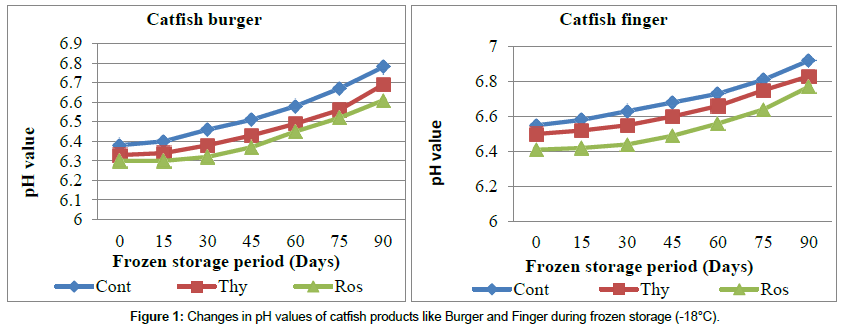
Figure 1. Changes in pH values of catfish products like Burger and Finger during frozen storage (-18°C).
Also, it was noticed that pH values were significantly (p ≤ 0.05) higher in control samples of all catfish burgers and fingers than that of samples treated by EOs and higher in samples treated by rosemary than that treated by thyme EOs. The changes in pH value during frozen storage of catfish products showed a gradual increase as the storage period extended by different rates, which might be due to the proteolytic enzymes that hydrolyzed fish protein to simple proteins, polypeptides, amino acids, ammonia and trimethylamine and other volatile bases [28]. The highest incremental rates were found in control samples than treated by EOs may be due to the effectiveness of these EOs as an antimicrobial agent so, it can be used as a way of combating the growth of common microorganisms causes of food poisoning [29].
pH values for burgers; control and samples treated by thyme and rosemary EOs were 6.38, 6.30 and 6.33, respectively at the beginning of frozen storage period increased to 6.78, 6, 61 and 6.69 at the end of storage period by about 6.2%, 4.7%, and 5.4% respectively, the same trend was found for finger samples; pH values of control and samples treated by thyme and rosemary EOs were 6.55, 6.41 and 6.50 increased to 6.92, 6.70 and 6.83 by about 5.3%, 4.3%, and 4.8%, respectively.
Therefore, the treatments by thyme followed by rosemary oils were more effective in delaying the rate of increasing pH value as antimicrobial agents compared with control and prolong shelf life period during the frozen storage. pH values of investigated fish products were very acceptance until the end of the storage period, where it were between 6.3-7.0 that proposed as acceptance limit of fish and fish products, whereas values above 7.0 were considered to be spoiled. Similar findings were reported by Aref et al., El-Lahamy et al., Ibrahim et al., and Rani et al. [21,27,30,31].
Total volatile basic-nitrogen content (TVB-N): The impact of the individual tested essential oils; (0.5%) thyme or rosemary oils on TVB-N values during frozen storage of raw catfish products was shown in Figure 2. It could be noticed that TVB-N contents of fingers products were higher than that of burgers products also TVB-N contents were higher in burgers and fingers control samples than that in samples treated with essential oils (EOs). The values of TVB-N content in raw catfish burgers and fingers stored at -18°C were gradually increased significantly (p<0.05) during the frozen storage period. These increments may be attributed to the breakdown of proteins as a result of the activity of microbial strains and proteolytic enzymes [32] or may be the result of deamination of free amino acids, oxidation of amines, and degradation of nucleotides by autolytic enzymes and microbial activity [33]. The highest significant (p<0.05) incremental of TVB-N values was recorded in control samples compared with samples treated by rosemary and thyme EOs, respectively. TVB-N value was 9.22 mg/100 g on weight basis (w.w.) for control burger samples while were 8.00 and 8.36 mg/100 g for samples treated with thyme and rosemary oils, respectively at zero time of storage increased to 15.55, 11.25 and 12.60 mg/100 g after 90 days of frozen storage. Also, TVB-N values were 10.05, 8.86 and 9.35 mg/100 g at zero time of storage increased to 16.34, 11.86 and 13.90 mg/100 g at the end of storage period for control fingers and samples treated with thyme and rosemary oils, respectively.
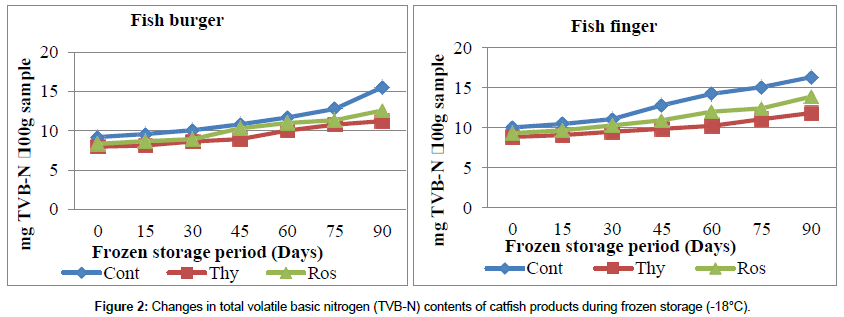
Figure 2. Changes in total volatile basic nitrogen (TVB-N) contents of catfish products during frozen storage (-18°C).
Therefore, samples treated by EOs; thyme followed by rosemary oils were more effective in delaying the rate of increasing TVB-N compared with samples of control burgers and fingers products during the frozen storage period, where the rate of increasing the TVB-N were 41%, 30% and 33% for burger control sample and burger samples treated by thyme and rosemary, respectively and were 38%, 25% and 32% for finger control sample and finger samples treated by thyme and rosemary, respectively. This may be attributed to the role of such oils on microbial population and bacterial growth as antimicrobial agents [34].
However, at the end of the frozen storage period, the TVB-N values for all burgers and fingers samples did not reach or exceed the acceptability limit (35 mg/100 g) stipulated and mentioned by Lang [35] and high quality of raw catfish burgers and fingers samples. These results are in agreement as reported by El-Lahamy et al., Mahmoudzadeh et al., Vanitha et al., and El-Sherif et al. [27,36-38].
Trimethylamine nitrogen (TMA-N) content: The changes in TMA-N of the different raw catfish burgers and fingers products during frozen storage at -18°C for 3 months are shown in Figure 3. From obtained data, it could be observed that TMA-N contents of fingers products were higher than that of burgers products. TVB-N contents were higher in burgers and fingers control samples than that in samples treated with essential oils (EOs). TMA-N values were gradually increased significantly (p<0.05) during the frozen storage period. TMA-N contents of fish burger samples were 1.35, 0.92 and 1.06 mg/100 g of control and samples treated with thyme and rosemary oils, respectively at the beginning of storage increased to 3.60, 2.05 and 2.45 mg/100 g sample after 3 months of frozen storage (end of storage period). Also, the same trend was found for fish fingers, TMA-N contents were increased from 1.70, 1.27 and 1.42 mg/100 g at zero time of storage for control and samples treated with thyme and rosemary oils to 3.95, 2.40 and 2.90 mg/100 g sample at the end of the storage period, respectively. Such increment of TMA-N of catfish burger and finger products during frozen storage may be due to the conversion of TMAO to TMA by the non-enzymatic process, or by native tissue enzymes or by bacterial enzymes (TMAase) which are not completely inactivated by low temperature [28].
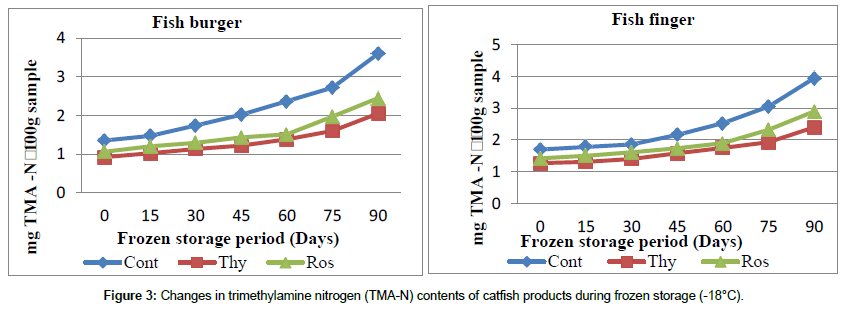
Figure 3. Changes in trimethylamine nitrogen (TMA-N) contents of catfish products during frozen storage (-18°C).
However, it has been mentioned that all catfish burgers and fingers products were considered as good quality and regarded within the acceptable limits less than 10 mg to 15 mg TMA-N/100 g until the end of storage period as reported by Connell [39].
Therefore, it was clear that the treatments by thyme followed by rosemary oils were more effective in delaying the rate of increasing TMA-N as antimicrobial factors and prolong shelf life period during the frozen storage compared with control samples. Also, the same results were found by Aref, El Lahamy et al. and Ibrahim et al. [21,27,30].
Thiobarbituric acid values (TBA)
The obtained results in Figure 4 revealed that the TBA values of raw burgers products were higher than that of fingers products may be due to the high-fat content of burgers samples. Also, the influences of individually (0.5%) thyme and rosemary essential oils were noticed; TBA values were significantly (p ≤ 0.05) lower in all treated catfish burger and finger samples than that of the control samples. From the obtained results, it was found that TBA values were gradually increased in all catfish burgers and fingers products. Therefore, although thyme followed by rosemary EOs had significant (p<0.05) reduction effect on the TBA values as antioxidants, there was an increase in TBA values in all different fish burger and finger samples throughout the frozen storage period by different rates affecting by kind of essential oil. At the beginning of the storage period TBA values of burger control and burger samples treated by thyme and rosemary were determined as 0.62, 0.38 and 0.47 mg malonaldehyde (MDA)/kg sample increased to 2.00, 1.10 and 1.48 mg MDA/kg samples, respectively at the end of storage period, while the values were 0.46,0.24 and 0.28 mg MDA/ kg samples for finger control and fingers samples treated by thyme and rosemary, respectively increased to 1.89, 0.80 and 1.08 MDA/kg samples, respectively at the end of storage period.
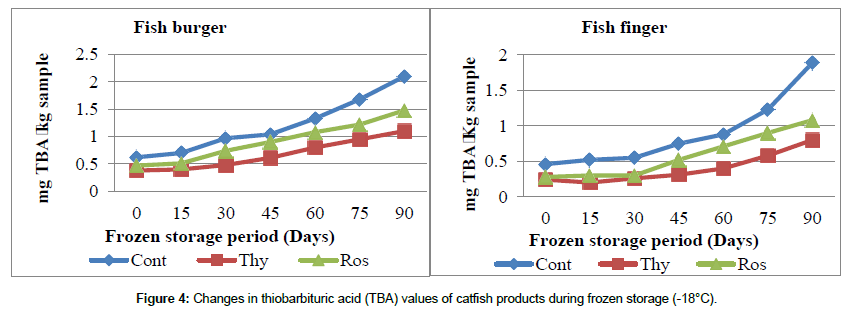
Figure 4. Changes in thiobarbituric acid (TBA) values of catfish products during frozen storage (-18°C).
The incremental in TBA values for all fish burger and finger samples with advancing the frozen storage time may be due to the auto-oxidation of fats, bacteriological and/or oxidative rancidity or may be due to ice crystals formed could injure the cell and cause the release of pro-oxidation, especially free iron [40,41]. However, the TBA values of all frozen raw catfish burgers and fingers samples were lower than the permissible limit (4.5 MDA/kg) as reported by Bonnell [42]. Accordingly, the raw burgers and fingers samples treated with thyme or rosemary and also control samples in the present study considered the good quality and accepted until and after the end of the frozen storage period. These results are in agreement with reported by Aref et al., Tokur et al., Ibrahim et al. and El-Sherif et al. [21,23,30,38].
Total bacterial count (TBC)
Figure 5 shows the changes of the total bacterial count of different raw burgers and fingers samples during frozen storage at -18°C for 3 months as affected by the addition of essential oils EOs; 0.5% thyme or 0.5% rosemary individually. From results, it was obvious that TBC count of fish burgers was lower than that of fish fingers at zero time of storage, control samples (untreated with EOs) showed the highest mean counts of TBC comparing to other samples treated with essential oils of thyme or rosemary that caused a significantly (p<0.05) reduction in microbial count of treated fish products immediately after preparation as antimicrobial. This antimicrobial activity of these essential oils could result from the hydrophobic nature which enables them to partition in the lipids of the bacteria cell membrane and mitochondria, disturbing the structures and rendering it more permeable [43].
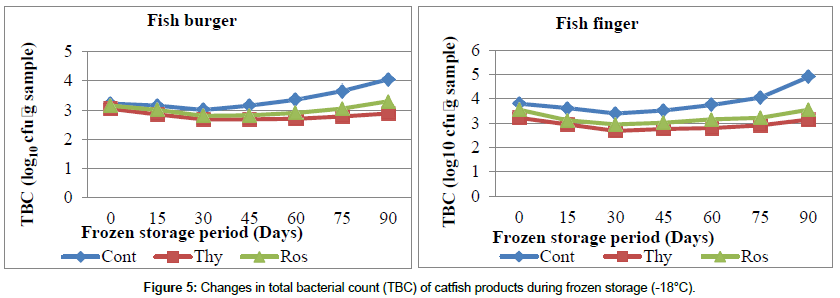
Figure 5. Changes in total bacterial count (TBC) of catfish products during frozen storage (-18°C).
TBC count was fluctuation decreasing and increasing during frozen storage until 60 days of storage then increased until the end of the storage period, initially reduction in the microbial load could be due to the freezing and the powerful antimicrobial properties of food additives and EOs. The initial TBC (log10 cfu/g sample) values for burgers; control and samples treated by thyme and rosemary EOs were 3.22, 3.04 and 3.11 log10 cfu/g sample at zero time of storage then fluctuation decreasing and increasing to 3.15, 2.70 and 2.90 log cfu/g sample at 60 days of storage then increased to 4.05, 2.88 and 3.30 log cfu/g sample, respectively at the end of storage period. While, the values of fingers; control and samples treated by thyme and rosemary EOs were 3.80, 3.22 and 3.55, respectively at zero time of storage then fluctuation decreasing and increasing to 3.75, 2.80 and 3.16 log10 cfu/g sample, respectively at 60 days of storage then increased to 4.90, 3.15 and 3.60 log10 cfu/g sample at the end of storage period. The increase of TBC may be attributed to the increase in simple nitrogenous compounds (amino acids and nucleotides) and fatty acids which were produced by hydrolysis of protein and fat by natural fish enzymes which consequently lead to suitable conditions for bacterial growth [21]. However, these levels did not exceed the maximum limits (7 log TBC/g) set for fresh and frozen fish products given by the International Commission on Microbiological Specifications for Foods [44]. These low values of TBC that found of raw catfish burgers and fingers indicated that good hygienic conditions were implemented during the processing of the products. Therefore the use of essential oils of thyme followed by rosemary reduced the microbial load of raw catfish burgers and fingers samples during frozen storage period compared to the control. These results are in agreement with found by Ibrahim et al., Rani et al., Vanitha et al., El-Sherif et al. and Awad [30,31,37,38,45].
Yeast and mould (Y and M) count
Figure 6 shows the changes of yeast and mould count of different raw catfish burgers and fingers samples during frozen storage as affected by addition of thyme and rosemary EOs individually. Yeast and mould was found of raw catfish burgers and fingers samples immediately after processing (zero time of storage) by low numbers account 0.60, 0.30 and 0.48 log10 cfu/g of burgers control and samples treated by thyme and rosemary, respectively while were 0.78, 0.48 and 0.70 log10 cfu/g of fingers control and samples treated by thyme and rosemary, respectively.
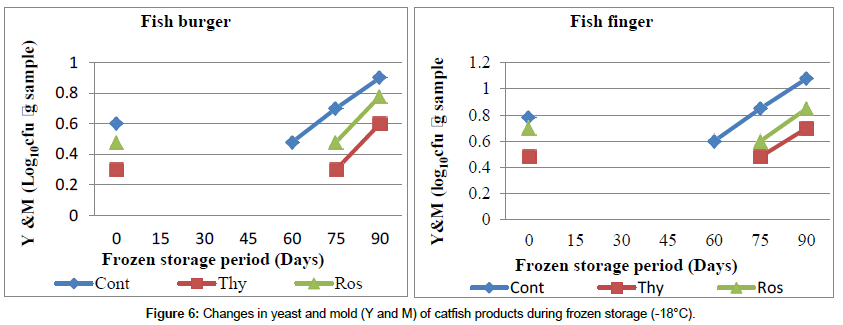
Figure 6. Changes in yeast and mold (Y and M) of catfish products during frozen storage (-18°C).
Freezing and EOs generally causes a reduction of yeast and mould and not detected in any of the products during the primary period of frozen storage through microbiological analysis after 15, 30 and 45 days of frozen storage, while after 60 days of storage the yeast and mould was appeared in raw control samples of burger and finger products by numbers of 0.48 in control burger and 0.60 log10 cfu/g sample in control finger. At 75 days of frozen storage the yeast and mould was appeared in all burgers and fingers products by numbers of 0.70, 0.30 and 0.48 log10 cfu/g for burgers control and samples treated by thyme and rosemary increased to 0.90, 0.60 and 0.78 log10 cfu/g sample, respectively at the end of storage period (90 days), while were 0.85, 0.48 and 0.60 log10 cfu/g for fingers control and samples treated by thyme and rosemary increased to 1.08, 0.70 and 0.85 log10 cfu/g sample, respectively at the end of storage period. This indicated that the yeast and mould was significantly (p ≤ 0.05) higher in control samples of all catfish burgers and fingers than that of samples treated by EOs and were higher in samples treated by rosemary than that treated by thyme EOs, may be due to EOs have strong inhibitory effect against the growth of yeast and mould count especially thyme higher than rosemary oils.
These results are in agreement with found by Mohamed [46] who found that the count of yeast and mold (Y and M) 10.6 × 102 cfu/g for tilapia fish during zero time of frozen storage (-18°C) decreased after 60 and 120 days in frozen sample to 5.0 and 3.33 × 102 cfu/g, respectively then sharply increased until the end of froze storage period (180 days) reached to 9.0 cfu/g sample. Also, it was [45] observed that mould and yeast recorded as 2.02 and 2.05 log10 cfu/g sample for raw burger and finger at the beginning of frozen storage at-18°C and not detected during frozen storage until the end of storage period. While [47] it was recorded that the yeast and mould number was 0.98 log cfu/g sample in fresh fish fingers but not detected during storage period until the end of frozen storage after 6 months.
Conclusion
The obtained results in this study showed the utilization of unaccepted catfish flesh from consumers in its fresh form in the production of good fish products; cold smoked catfish fillets, catfish burgers and fingers products high safely, having good quality and better acceptability with lowering the costs. The tested essential oils (EOs); thyme, rosemary, and cumin had high effectiveness as an antioxidant, antimicrobial and should be utilized for extending the shelf-life and enhancing quality attributes of smoked catfish products during cold storage and raw catfish burgers and fingers during frozen storage. The chemical, physicochemical, microbiological, the sensory analysis revealed that raw catfish burgers and fingers slightly affected by frozen storage at -18°C until the end of the storage period (3 months). Catfish burgers and fingers are of high quality and acceptance even after the storage period is over.
REFERENCES
- Venugopal V, Shahidi F, Lee TC (1995) Value added products from underutilized fish species. Food Sci Nutr 35: 431-453.
- Francis-Floyd R (2002) Fish Nutrition: Institute of Food and Agricultural Sciences.
- Nelson JS, Grande TC, Wilson MVH (2016) Fishes of the world. Animal Science and Zoology. John Wiley and Sons Inc. 5th Edition.
- El-Sherif SA (2014) Utilization of some uneconomic fish in production fish products. Final report of project, Fisheries Division, National Institute of Oceanography and Fisheries, Cairo, Egypt.
- Cakli SK, Taskaya L, Kisla D, Celik U, Ataman CA, et al. (2005) Production and quality of fish fingers from different fish species. Eur Food Res Technol 220: 526-530.
- Khalil KI, El-Sherif SA, Mahmoud AA, Awad AA (2015) quality evaluation and nutritional value of high value added fish products made from low economic fish. J Food Sci 43: 1-13.
- Hall GM (2011) Freezing and chilling of fish and fish products. Blackwell Publishing Ltd, pp: 77-97.
- Jessen F, Nielsen J, Larsen E (2014) Chilling and freezing of fish. Seafood processing, pp: 33-59.
- Alizadeh E, Chapleau N, De lamballerie M, Le-bail A (2007) Effect of different freezing processes on the microstructure of Atlantic salmon (Salmo salar) fillets. Innov Food Sci Emerg Technol 8: 493-499.
- Mexis SF, Chouliara E, Kontominas MG (2009) Combined effect of an oxygen absorber and oregano essential oil on shelf life extension of rainbow trout fillets stored at 4°C. Food Microbiol 26: 598-605.
- Benjakul S, Visessanguan W, Thongkaew C, Tanaka M (2005) Effect of frozen storage on chemical and gel-forming properties of fish commonly used for surimi production in Thailand. Food Hydrocoll 19: 197-207.
- Singh G, Marimuthu P, Murali H, Bawa A (2005) Antioxidative and antibacterial potentials of essential oils and extracts isolated from various spices materials. J Food Saf 25: 130-145.
- Nakatani N (1994) Antioxidative and antimicrobial constituents of herbs and spices, in: spices, herbs and edible fungi (ed. G. Charalambous). Elsevier Science, New York, pp: 251-271.
- Shelef L, Naglik O, Bogen D (1980) Sensitivity of some common food-borne Bacteria to the spices sage, rosemary and allspice. J Food Sci 45: 1042-1044.
- Corbo MR, Bevilacqua A, Campaniello D, Amato D, Speranza B, et al. (2009) Prolonging microbial shelf-life of foods through the use of natural compounds and non-thermal approaches-A review. Int J Food Sci Technol 44: 223-241.
- Rıznar K, Celan S, Knez Z, Skerget M, Bauman D, et al. (2006) Antioxidant and antimicrobial activity of rosemary extract in chicken frankfurters. Food Chem Toxicol 71: 425-429.
- Kenar M, Ozogul F, Kuley E (2010) Effects of rosemary and sage tea extracts on the sensory, chemical and microbiological changes of vacuum-packed and refrigerated sardine (Sardina pilchardus) fillets. Int J Food Sci Technol 45: 2366-2372.
- Makri M (2013) Effect of oregano and rosemary essential oils on lipid oxidation of stored frozen minced gilthead sea bream muscle. J Verbrauch Lebensm 8: 67-70
- Kostaki M, Giatrakou V, Savvaidis IN, Kontominas MG (2009) Combined effect of MAP and thyme essential oil on the microbiological, chemical and sensory attributes of organically aqua cultured sea bass (Dicentrarchus labrax) fillets. Food Microbiol 26: 475-482.
- Hyldgaard M, Mygind T, Meyer RL (2012) Essential oils in food preservation: Mode of action, synergies, and interactions with food matrix components. Front Microbiol 3: 1-24.
- Aref S, Morsy N, Ramadan AH, Zayat FM (2016) Effect of transglutaminase enzyme and some natural antioxidants on the quality of ready to eat catfish fingers during frozen storage. Suez Canal Univ J Food Sci 3: 45-55.
- Al-Bulushi IS, Stefan K, Hamed A, Sultan A (2005) Evaluating the quality and storage stability of fish burger during frozen storage. Fish Sci 71: 648-654.
- Tokur B, Özkütük S, Atıcı E, Özyurt G, Özyurt CE (2006) Chemical and sensory quality changes of fish fingers made from mirror carp (Cyprinus carpio L., 1758) during frozen storage (-18ºC). Food Chem 99: 335-341.
- Pearson D (1991) The chemical analysis of food .Churchill, New York, London, 7th Edition, pp: 374-410.
- AOAC (2012) Association of official analytical chemists. Official Methods of Analysis, 19th Edition.
- APHA (1992) American Public Health Association. In M. L. Speck (Ed.) Compendium of methods for microbiological examination of foods. Washington, D.C.
- El-Lahamy AA, Khalil KI, El-Sherif SA, Mahmud AA (2018) Changes in quality attributes of sand smelt (Atherina hepsetus) fish burger and finger during frozen storage. J Fish Res 2: 1-11.
- El-Sherif SA, Ibrahim SM, Abou-Taleb M (2011) Relationship between frozen pre-storage period on raw tilapia and mullet fish and quality criteria of its cooked products. Egypt J Aquat Res 37:183-189.
- Fisher K, Phillips CA (2006) The effect of lemon, orange and bergamot essential oils and their components on the survival of Campylobacter jejuni, Escherichia coli O157:H7, Listeria monocytogenes, Bacillus cereus and Staphylococcus aureus in vitro and in food systems. J Appl Microbiol 101: 1232-1240.
- Ibrahim SM, El-Sherif SA (2008) Effect of some plant extracts on quality aspects of frozen tilapia (Oreachromis niloticus L.) Global Veterinaria 2: 62-66.
- Rani ST, Dhanapal K, Reddy GVS, Reddy DRK, Sravani K, et al. (2017) Quality assessment of mince based products made from mrigal (Cirrhinus mrigala) during frozen storage. Int J Curr Microbiol App Sci 6: 3230-3241.
- Yassin-Nessrien M, Abou-Taleb M (2007) Antioxidant and antimicrobial effects of marjoram and thyme in coated refrigerated semi fried mullet fish fillets. World J Dairy Food Sci 2: 1-9.
- Ocaño-Higuera VM, Maeda-Martínez AN, Marquez-Ríos E, Canizales-Rodríguez DF, Castillo-Yáñez FJ, et al. (2011) Freshness assessment of ray fish stored in ice by biochemical, chemical and physical methods. Food Chem 125: 49-54.
- Sacchetti G, Maietti S, Muzzoli M, Scaglianti M, Manfredini S, et al. (2005) Comparative evaluation of 11 essential oils of different origin as functional antioxidants, antiradicals and antimicrobials in foods. Food Chem 91: 621-632.
- Lang K (1983) Der fluchtige basenstickstoff (TVB-N) bei im binnenland in den verkehr gebrachten frischen seeficchen. 11. Mitteilung. Archiv für Lebensmittelhygiene 34: 7-10.
- Mahmoudzadeh M, Motallebi AA, Hosseini H, Haratian, P Ahmadi H, et al. (2010) Quality assessment of fish burgers from deep flounder (Pseudorhombus elevatus) and brushtooth lizardfish (Saurida undosquamis) during storage at -18ºC. Iran J Fish Sci 9: 111-126.
- Vanitha M, Dhanapal K, Sravani K, Reddy VSG (2013) Quality evaluation of value added mince based products from (Catla catla) during frozen storage. Int J Sci Environ Technol 2: 487-501.
- El-Sherif SA, Abd El-Ghafour S (2016) Effectiveness of garlic, rosemary and ginger essential oils on improve the quality and shelf life of Bagrus bayad fish sausage preserved by cold storage. Int J Adv Res 4: 276-289.
- Connell JJ (1976) Control of fish quality. Fishing New Books, NY, pp: 127-129.
- Benjakul S, Bauer F (2001) Biochemical and physicochemical changes in catfish (Silurus glanis L.) as influenced by different freeze-thaw cycles. Food Chem 72: 207-217.
- Osman MF, Zidan NS (2014) Quality assessment of formulated fish silver carp burgers during frozen storage. J Food Dairy Sci Mansoura Univ 5: 403-419.
- Bonnell AD (1994) Quality assurance in seafood processing: A practical guide. Chapman and Hall, London, U.K., pp: 74-75.
- Sikkema J, DeBont JAM, Poolman B (1994) Interactions of cyclic hydrocrbons with biological membranes. J Biol Chem 269: 8022-8028.
- ICMSF (2002) International commission on microbiological specifications for foods microorganisms in foods: Microbiological testing in food safety management, Kluwer Academic/Plenum Publishers, New York, pp: 258-259.
- Awad AA (2013) Production and evaluation of some high value added fish products from low economic fish. Faculty of Agriculture, Fayoum University, Egypt.
- Mohamed HR (2018) Quality evaluation of some fishes and their products obtained from fish farms, Fayoum Governorate. Ph. D Thesis, Faculty of Agriculture, Fayoum University, Egypt.
- Izci L, Bilgin S, Günlü A (2011) Production of fish finger from sand smelt (Atherina boyeri, RISSO 1810) and determination of quality changes. Afr J Biotechnology 10: 4464-4469.
Citation: Saleem MS, El-Sherif SA, Sharaf AM, Abo-Zeid KS (2019) Influence of Essential Oils and Frozen Storage on Quality Parameters of Catfish (Clarias gariepinus) Burgers and Fingers. J Food Process Technol 10: 801.
Copyright: © 2019 Saleem MS, et al. This is an open-access article distributed under the terms of the Creative Commons Attribution License, which permits unrestricted use, distribution, and reproduction in any medium, provided the original author and source are credited.
